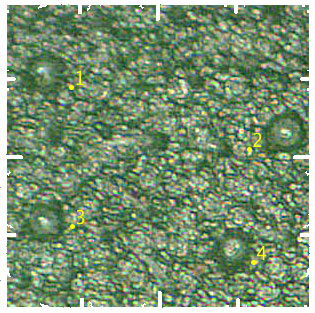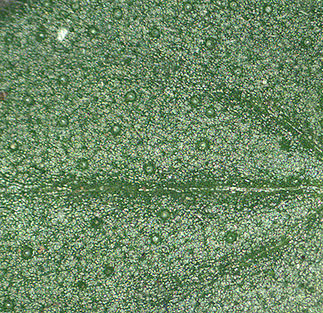

Sparse glands on upper large leaf of probable hybrid of H. drummondii & H. reverchonii var. ???
Click for larger image
Scent with Hybrids within the Hedeoma drummondii Complex
by Bob Harms

A Baseline for Scent Identification
In 1973 R.S. Irving and R.P. Adams expanded on a major finding in Irving's 1968 dissertation, the correlation between the scent–producing volatile terpenoid components and clearly recognizable freshly collected taxa (recognizing at that time H. reverchonii var. reverchonii and H. reverchonii var. serpyllifolia as distinct from H. drummondii). The basic results were (listing only the major, scent–determining components; p. 191):
Percentage of monoterpenes for each taxon1:
| Monoterpene | HEDR | HERE | HESE | associated scent |
| Pulegone | 50.0 | --- | --- | peppermint |
| Isomenthone | 40.0 | --- | --- | mint |
| β-Pinene | Tr2 | Tr2 | 30.0 | camphor |
| Bornel | --- | 3.5 | 26.0 | camphor |
| Camphene | Tr2 | 1.0 | 17.0 | camphor |
| Geranial | --- | 31.7 | Tr2 | lemon |
| Citronellal | --- | 22.0 | Tr2 | citrus |
| Neral | --- | 21.0 | Tr2 | lemon |
14-letter abbreviations may be used for the 3 taxa on this web site.
2Tr =< 1%.
Irving & Adams further note (192):
Although there is quantitative variation found both within and between populations, the overall quantitative and qualitative profile remains invariable.
Scent Identification with Hybrids
Although the scent correlation has become the basis for recent keys, hybridization among the 3 taxa, examined in detail by Irving, presents a serious problem when scent is the sole basis for field identifications.
Irving & Adams created hybrids and determined values for an F1 generation, and then F2 generation for some 106 H. drummondii × H. r. var. serpyllifolia F1 plants.
Mean percentage of monoterpenes in F1 generations (if > 5%), p. 193:
| Monoterpene | HEDR ×
HESE | HEDR ×
HERE | HESE ×
HERE | associated scent |
| Camphene | 6.1 | 0.1 | 5.2 | camphor |
| d-Limonene | 8.7 | 5.8 | 3.0 | citrus |
| Menthone | 11.9 | 7.8 | --- | mint |
| Isomenthone | 13.5 | 10.4 | --- | mint |
| Pulegone | 16.5 | 22.5 | --- | peppermint |
| Bornel | 15.9 | 1.2 | 13.6 | camphor |
| t-Ocimene | --- | 3.4 | 8.1 | citrus |
| Citronellal | --- | 5.3 | 2.5 | citrus |
| Neral | --- | 5.6 | 10.8 | lemon |
| Geranial | --- | 12.5 | 19.0 | lemon |
Among their F2 generation they found (p.194):
The largest group (27.0 percent of the F2 generation) displayed
patterns which approximated the qualitative and quantitative patterns of
the F1 hybrid.
Implications for field identification
Identifying a plant as a hybrid in the absence of distinguishing morphological characteristics may or may not be possible. But a clash of scent with the expected characteristics is a sure sign of hybridization. Winter leaves and habit of H. drummondii are very distinct. The following shoot base was assumed to be H. reverchonii, variety uncertain, when it was examined in late January (when its glands are often weakly developed and don't produce a clear scent, in contrast with H. drummondii).

Probable hybrid of H. drummondii & H. reverchonii var. ??? origin, winter leaves & stem.
The broad leaves and spreading hairs clearly rule out H. drummondii. In late March the habit of the plant did not seem to match either H. r. var. reverchonii or H. r. var. serpyllifolia, both of which had been growing next to it for 2 months. I decided to test the scent: my wife and I independently felt it was both lemon and mint, the latter being somewhat stronger, but definitely not the sharp peppermint associated with H. drummondii (even with winter leaves). A branchlet was collected and two days later tested for scent, and a new observer's first response was mint (but not the peppermint of H. drummondii, then camphor was also sensed. Six hours later the primary scent was camphor, and mint barely perceptible. [Compare the relative percentages for Pulegone (peppermint) in the above tables. With F1 it is much weaker.] This plant will be scent–tested when fully mature leaves with well–developed glands are available.
Plant Resources Center Home Page — Flora of Texas
— Hedeoma





